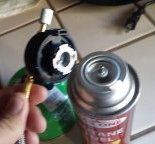Under Construction 
Types | Sample listing | Fuels | Hydrocarbon Fuels | Manufacturers | General Information | Operating tips | evaluation and choosing tips
Types:
 Butane, Propane or Isobutane Blend Canisters
Butane, Propane or Isobutane Blend Canisters
Pros: Convenient, clean burning
Can be adjusted easily for simmering
Can't spill.
Cons: Canisters may be hard to find and are non-recyclable.
More expensive
Performance may decrease in temperatures below freezing.
White Gas/Camp Stove fuel:

 Pros: Very inexpensive, easy to find throughout the world.
Pros: Very inexpensive, easy to find throughout the world.
Cons: jamming, clogging and pump failures.
Alcohol:
 Pro: Alcohol, unlike white gas, butane and propane, is not a petroleum by-product and is less damaging to the environment.
Pro: Alcohol, unlike white gas, butane and propane, is not a petroleum by-product and is less damaging to the environment.
safest stove fuel for use in confined areas. Alcohol vapor is relatively light compared to the vapor of petroleum fuels, and is less likely to concentrate and create a hazard. Alcohol stoves don't flare up as often as white gas stoves.
Faster setup time.
Cons: The fuel cup is open, so if the stove is knocked over, burning alcohol can spill out. Alcohol stoves have blue flames that can be difficult to see in direct sun light.
They only produce about half the heat output of other stoves, so boiling time for 2 cups (1/2 l) is 5-8 min vs 3-4 min.
1/2 oz of alcohol will burn for about 10 min.
 Solid Fuel - Stoves that run on:
Solid Fuel - Stoves that run on:
twigs, small pieces of wood, or charcoals
Sterno® (Canned Heat™)
Sample of Stoves 2013
Model Wgt. Capacity Boil Time Water Boiled/fuel Fuel $/oz or g $ to boil 1-Liter
MSR Liquid Fuel
DragonFly
WhisperLite
WhisperLite International
Chittenden Vermont just outside of Rutland
Source: EMS Store
Sample of Stoves 2008
* Boil times came from independent tests. Mfg. Ratings are lower.
1. Coleman Dual-fuel - Camp stove fuel or unleaded gasoline.
Coleman 2 burner duel-fuel Camp Stove:
Main burner supplies 21,000 BTU; with auxiliary burner lit, main supplies 11,500 BTU, auxiliary supplies 9,500 BTU
2. Cabela is a propane stove.
New Designs:
Integrated systems with pots with heat exchangers were the fad in 2007:
Examples are: Primus EtaPower EF, JetBoil and MSR Reactor.
Primus Eta is a little more bulky and heavier but is more stable, simmers better and accepts a larger variety of pots.
Multifuel stoves
The year the Primus Multifuel stove was introduced it made a huge splash at the Outdoor Retail Expo (the convention where all sorts of gear-store employees and gear junkies beg and borrow to get into each year) when Primus ran it for several days straight on 151-proof rum. A few other stoves could briefly burn "Bacardi 151", but they would usually clog and need cleaning after just a few hours. In addition to burning on bad fuel and boiling a quart of water really fast, this stove can trim the flame down to a low simmer without sputtering out.
What was even more impressive was that Primus had the foresight to make the stove compatible with both liquid-fuel bottles and compressed gas cartridges. I know most backpackers spending more than a week in the backcountry or out in the winter prefer liquid fuel, but canisters are cheaper if you don't go camping that often and always easier & safer for new campers to use.
The newest multifuel stoves (e.g. MSR XGK and Primus Omnifuel) add the ability to run on vegetable oil (aka: biodiesel) but the original Primus Multifuel is still a fast-cooking, durable stove worth a look.
Source: HikerDeals.com/camp-tips/
Burns gas canisters/cartridges with a butane-propane mix, white gas, auto petrol/auto gas, diesel, kerosene/ paraffin and jet fuel.
Fuels:
Summary: See Hydrocarbon Fuels in chemistry for more information.
Source: ZenStoves.net, CampfireDude.com and others.
Portable stove Fuel Comparison- Wikipedia,
In many places today you will see camp stove (e.g. Coleman) fuel and white gasoline used synonymously. They are not the same. Coleman Fuel was developed in the early 50's as a replacement for "white gas". Coleman fuel contains components (such as naphtha) that are much less volatile than gasoline .
See Also: Hydrocarbon Fuels
Carbon Chain - Carbon atoms in each molecule.
MJ/l - megajoules per liter - Energy Content
Canisters:
 
Source: The GO Outdoors Guide To Fuel and Gas

Basically, there are two common modern gas canisters suitable for backpackers, Camping Gaz (non-threaded) and 7/16ths UNEF threaded (Lindal Valve) canisters. Generally, stoves built for one type will not work with the other, but there are exceptions such as the relatively heavy MSR Superfly. There are also much lighter DIY exceptions such as the "Super Gnat" that you can assemble in the matter of a few minutes.
 
In most of the developed world, the standard for gas canisters for backpacking is a threaded canister with a 7/16ths UNEF thread.
Source: Adventures In Stoving: Backpacking Gas Canisters 101
Manufacturers:
MSR (Mountain Safety Research)
Coleman
GAZ (Most of the links are to SuuntoUSA.com, but they don't have GAZ now)
Primus
Optimus
Links:
General Information:
Zen Backpacking Stoves - Canister Stoves at ZenStoves.net
Stoves for Camping
Zen Canister Stoves - Liquefied Gas Stoves
Nov. 2001 issue of Boots and Blisters
Operating tips:
Cold Weather Operation at ZenStoves.net
Operation in the Wind
Camp Tips at HikerDeals.com
Choosing a stove:
How to choose a stove at REI
Comparing Stoves and Fuel at Mtn. Equip. Co-op Canada
Stove Reviews at TheBackPacker.com
Stoves Compared at ArtOfTravel.com
A guide to Camp Stoves at the AMC
Stoves Comparison (pdf) at Wilds of Manitoba
Hydrocarbon Fuels
Soda Can Stoves:
Soda Can Stoves in Recreation
Return to Products
last updated 20 June 2008
|


